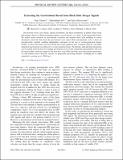| dc.contributor.author | Varma, Vijay | |
| dc.contributor.author | Isi Banales, Maximiliano S | |
| dc.contributor.author | Biscoveanu, Sylvia | |
| dc.date.accessioned | 2020-05-22T20:30:51Z | |
| dc.date.available | 2020-05-22T20:30:51Z | |
| dc.date.issued | 2020-03 | |
| dc.date.submitted | 2020-01 | |
| dc.identifier.issn | 1079-7114 | |
| dc.identifier.issn | 0031-9007 | |
| dc.identifier.uri | https://hdl.handle.net/1721.1/125433 | |
| dc.description.abstract | Gravitational waves carry energy, angular momentum, and linear momentum. In generic binary black hole mergers, the loss of linear momentum imparts a recoil velocity, or a “kick,” to the remnant black hole. We exploit recent advances in gravitational waveform and remnant black hole modeling to extract information about the kick from the gravitational wave signal. Kick measurements such as these are astrophysically valuable, enabling independent constraints on the rate of second-generation merger. Further, we show that kicks must be factored into future ringdown tests of general relativity with third-generation gravitational wave detectors to avoid systematic biases. We find that, although little information can be gained about the kick for existing gravitational wave events, interesting measurements will soon become possible as detectors improve. We show that, once LIGO and Virgo reach their design sensitivities, we will reliably extract the kick velocity for generically precessing binaries—including the so-called superkicks, reaching up to 5000 km/s. | en_US |
| dc.publisher | American Physical Society | en_US |
| dc.relation.isversionof | http://dx.doi.org/10.1103/PhysRevLett.124.101104 | en_US |
| dc.rights | Article is made available in accordance with the publisher's policy and may be subject to US copyright law. Please refer to the publisher's site for terms of use. | en_US |
| dc.source | American Physical Society | en_US |
| dc.title | Extracting the Gravitational Recoil from Black Hole Merger Signals | en_US |
| dc.type | Article | en_US |
| dc.identifier.citation | Varma, Vijay, Maximiliano Isi, and Sylvia Biscoveanu. "Extracting the Gravitational Recoil from Black Hole Merger Signals." Physical Review Letters, 124, 10 (March 2020): 101104. © 2020 American Physical Society | en_US |
| dc.contributor.department | Massachusetts Institute of Technology. Department of Physics | en_US |
| dc.contributor.department | LIGO (Observatory : Massachusetts Institute of Technology) | |
| dc.relation.journal | Physical Review Letters | en_US |
| dc.eprint.version | Final published version | en_US |
| dc.type.uri | http://purl.org/eprint/type/JournalArticle | en_US |
| eprint.status | http://purl.org/eprint/status/PeerReviewed | en_US |
| dc.date.updated | 2020-03-13T14:30:35Z | |
| dc.language.rfc3066 | en | |
| dc.rights.holder | American Physical Society | |
| dspace.date.submission | 2020-03-13T14:30:35Z | |
| mit.journal.volume | 124 | en_US |
| mit.journal.issue | 10 | en_US |
| mit.license | PUBLISHER_POLICY | |
| mit.metadata.status | Complete | |
